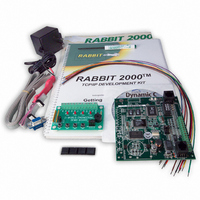101-0401 Rabbit Semiconductor, 101-0401 Datasheet - Page 36

101-0401
Manufacturer Part Number
101-0401
Description
KIT DEV RABBIT2000/TCP/IP
Manufacturer
Rabbit Semiconductor
Series
RabbitCore 2000r
Type
MPU Moduler
Datasheet
1.101-0402.pdf
(82 pages)
Specifications of 101-0401
Rohs Status
RoHS non-compliant
Contents
Rabbit 2000™ TCP/IP Development Board, Demo Board, Power Supply, Cable and Software
Processor To Be Evaluated
Rabbit 2000
Interface Type
RS-232, RS-485
For Use With/related Products
RCM2000, RCM2010, RCM2020
Lead Free Status / Rohs Status
Lead free / RoHS Compliant
Other names
101-0401
316-1005
Q906133
316-1005
Q906133
4.2 Primer on IP Addresses
Obtaining IP addresses to interact over an existing, operating, network can involve a num-
ber of complications, and must usually be done with cooperation from your ISP and/or
network systems administrator. For this reason, we recommend a direct connection
between a PC and the TCP/IP Development Board using an Ethernet crossover cable or a
simple arrangement with a hub. (A crossover cable should not be confused with regular
straight through cables.) The hub and a wide variety of cables can also be purchased from
a local computer store.
In order to set up this direct connection, you will need a PC without networking, or dis-
connect a PC from the corporate network, or install a second Ethernet adapter and set up a
separate private network attached to the second Ethernet adapter. Disconnecting your PC
from the corporate network may be easy or nearly impossible, depending on how it is set
up. Mobile PCs, such as laptops, are designed to be connected and disconnected, and will
present the least problem. If your PC boots from the network or is dependent on the net-
work for some or all of its disks, then it probably should not be disconnected. If a second
Ethernet adapter is used, be aware that Windows TCP/IP will send messages to one
adapter or the other, depending on the IP address and the binding order in Microsoft prod-
ucts. Thus you should have different ranges of IP addresses on your private network from
those used on the corporate network. If both networks service the same IP address, then
Windows may send a packet intended for your private network to the corporate network.
A similar situation will take place if you use a dial-up line to send a packet to the Internet.
Windows may try to send it via the local Ethernet network if it is also valid for that network.
The following IP addresses are set aside for local networks, and are not allowed on the
Internet: 10.0.0.0 to 10.255.255.255, 172.16.0.0 to 172.31.255.255, and 192.168.0.0 to
192.168.255.255.
The TCP/IP Development Board uses a 10Base-T type of Ethernet connection, which is
the most common scheme. The RJ-45 connectors are similar to U.S. style telephone con-
nectors, are larger and have 8 contacts.
An alternative to the direct connection using a crossover cable is a direct connection using
a hub. The hub relays packets received on any port to all of the ports on the hub. Hubs are
low in cost and are readily available. The TCP/IP Development Board uses 10 Mbps
Ethernet, so the hub or Ethernet adapter must be either a 10 Mbps unit or a 10/100 Mbps
unit.
TCP/IP Development Kit
32













